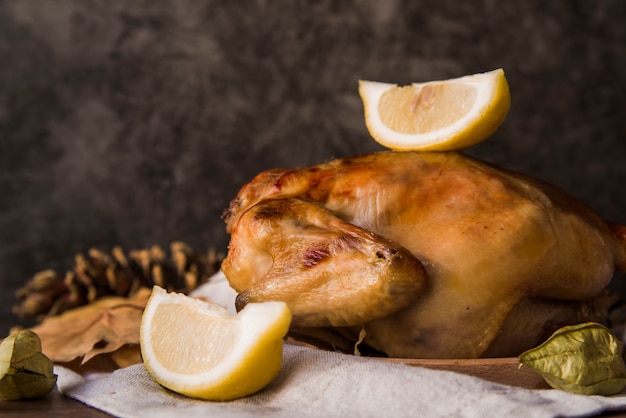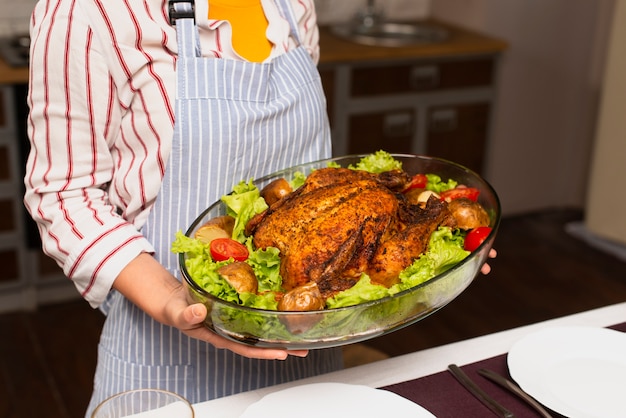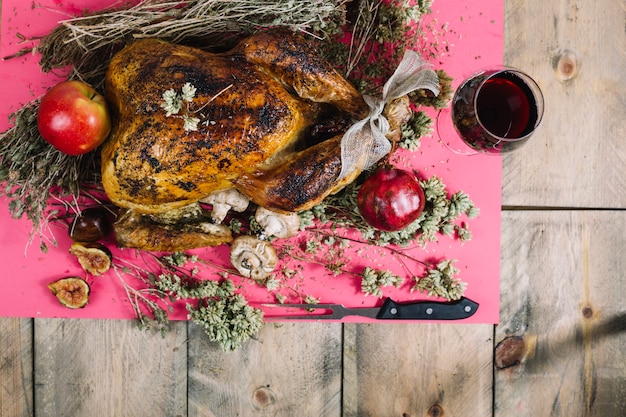Let me tell you, there's nothing quite like a perfectly roasted cornish hen. It's a real crowd-pleaser, especially for those cozy dinners where you're after something a bit special but don't want to spend ages in the kitchen. I remember the first time I tried a roasted cornish hen. It was at a friend's house, and I was blown away by how tender and flavorful it was. I knew then and there that I had to master this dish. Over the years, I've been perfecting my cornish hen recipe, and I'm finally ready to share it with you. But before we dive into the details, let's talk about the main event – the cooking time!
The Importance of Timing: The Cornish Hen at 350 Degrees

Cooking a Cornish hen at 350 degrees fahrenheit (175 degrees Celsius) is a classic choice for good reason. It's a gentle heat that allows the meat to cook evenly and stay juicy, without drying out. Remember, the goal is to achieve that perfect balance of crispy skin and succulent, tender meat. But how long do you actually need to roast it at this temperature? Well, that depends on the size of your hen, of course.
A General Guide:
As a rule of thumb, a 1-pound Cornish hen will take about 30-40 minutes to cook at 350 degrees. But that's just a starting point. You see, Cornish hens can vary in size quite a bit. Sometimes you'll find a smaller, more petite hen, and sometimes you'll find a larger, more robust one. That's why I always recommend using a meat thermometer. It's the only way to ensure your hen is cooked through to perfection.
Using the Meat Thermometer: The Key to Perfection
I can't stress enough how important a meat thermometer is for this recipe. It's the only way to guarantee your hen is perfectly cooked. You don't want to undercook it (yikes, food poisoning!), and overcooking can turn the meat dry and tough. Think of it as your secret weapon, your culinary compass that guides you to the perfect internal temperature.
Here's how to use it: Insert the thermometer into the thickest part of the thigh, making sure it doesn't touch any bone. The goal is to reach an internal temperature of 165 degrees Fahrenheit (74 degrees Celsius). This is the magic number that ensures the hen is cooked through and safe to eat. Once it registers 165 degrees, you're good to go!
(Part 1) The Art of Cornish Hen Roasting: A Step-by-Step Guide

Now, let's get to the fun part – the actual roasting! I'm going to walk you through my tried-and-true method, step by step, so you can achieve a perfectly golden, juicy cornish hen that's sure to impress.
Preparing the Hen
First things first, preheat your oven to 350 degrees Fahrenheit (175 degrees Celsius). This is a crucial step, as it ensures the oven is at the ideal temperature when your hen goes in. While the oven is preheating, prepare your hen. Pat it dry with paper towels to remove any excess moisture, which can lead to steam and hinder the browning process. Now, it's time to season! Generously sprinkle salt, pepper, and any other herbs or spices you fancy. I like to use a blend of herbs like rosemary, thyme, and sage for a classic flavour, but feel free to get creative! You can add a pinch of paprika for a touch of smoky depth, or a squeeze of lemon zest for a bright citrusy note. The world is your oyster (or rather, your spice rack!).
Stuffing the Hen (Optional)
Now, for the optional but oh-so-delicious step – stuffing! If you want to add an extra flavour punch, you can stuff the hen with your favourite stuffing. I've found that a simple stuffing made with bread crumbs, onions, herbs, and butter works wonders. The key here is to pack the stuffing loosely, so it doesn't burst during cooking. Imagine it like a little pillow of flavour inside the hen. You can experiment with different flavour combinations. Perhaps a sage and sausage stuffing for a hearty touch, or a cranberry and pecan stuffing for a festive vibe.
Roasting the Hen
Place the hen in a roasting pan. Now, here's a little trick I learned from my grandma: drizzle the hen with melted butter and a little olive oil. This will help the skin crisp up beautifully, achieving that golden-brown perfection we all crave. You can also add some chopped vegetables to the pan, like carrots, potatoes, or onions. These will soak up all the delicious juices as the hen roasts, making a tasty side dish that complements the main event perfectly.
(Part 2) Mastering the Roast: Tips and Tricks

Now, let's talk about a few key tips that will take your Cornish hen roasting game to the next level!
Basting for Extra Moisture
I like to baste my hen with the pan juices every 15-20 minutes while it roasts. This keeps the skin moist and helps it achieve that beautiful golden-brown colour. Think of it as a little love tap, ensuring the skin doesn't dry out and stays beautifully glossy. You can use a spoon or a basting brush for this. If you're using vegetables in the pan, you can toss them with the pan juices as well. This will ensure they don't dry out and absorb all the wonderful flavours from the hen.
Resting Time: Don't Skip This!
Once the hen is cooked through, take it out of the oven and let it rest for about 10 minutes before carving. This allows the juices to redistribute throughout the meat, making it even more tender and juicy. Think of it as a little timeout for the hen, allowing the flavours to settle and the meat to relax. While you're waiting, you can make your gravy.
(Part 3) The Delicious Side of Cornish Hen: Gravy and Sides
No Cornish hen dinner is complete without a delicious gravy! And the best part is, you can make it right from the pan juices. It's like a little culinary magic trick, transforming those flavorful juices into a rich, savory gravy.
Making a Simple Pan Gravy
While the hen is resting, pour the pan juices into a saucepan. Skim off any excess fat, as this can make the gravy greasy. Bring the juices to a simmer and whisk in a tablespoon of cornstarch mixed with a tablespoon of water. Simmer for a couple of minutes, until the gravy thickens. Season with salt and pepper to taste. You can even add a pinch of herbs or spices for an extra flavour boost.
side dishes to Pair with Your Cornish Hen
Now, let's talk sides. What goes best with Cornish hen? Well, there's a whole world of options! Here are a few favourites:
- Roasted vegetables: Carrots, potatoes, onions, asparagus, Brussels sprouts, and more. You can roast them with the hen, or separately. I like to roast them with the hen for a truly flavorful experience, as they absorb the delicious drippings.
- Green salad: A simple green salad adds freshness and lightness to the meal, balancing the richness of the hen and gravy.
- Wild rice pilaf: The nutty flavour of wild rice pairs perfectly with Cornish hen, creating a delightful textural contrast.
- mashed potatoes: A classic comfort food that always goes well with roasted poultry, providing a creamy and comforting counterpoint to the crispy hen.
- Cornbread: For a Southern touch, try serving your hen with cornbread. The sweet and crumbly cornbread adds a delightful contrast to the savory hen.
(Part 4) Serving and Enjoying Your Roasted Cornish Hen
Now that your hen is cooked, rested, and ready to go, it's time to plate it up!
Carving the Hen
Carving a Cornish hen is simple. Use a sharp knife to cut along one side of the breastbone. Then, carefully lift the breast away from the bone. Repeat on the other side. You can then cut the legs and thighs from the carcass.
Plating and Presentation
Arrange the carved hen on a serving platter. Serve with your chosen sides and a generous ladle of gravy. Don't forget a little sprig of fresh rosemary or thyme for a touch of elegance. This simple garnish adds a touch of freshness and sophistication to your dish.
(Part 5) Variations and Ideas
Now that you've mastered the basic recipe, it's time to get creative!
Flavourful Rubs and Marinades
Instead of just salt and pepper, you can experiment with different spice rubs and marinades. For a smoky flavour, try a rub made with paprika, cumin, and garlic powder. For a citrusy kick, marinate the hen in a mixture of lemon juice, olive oil, and herbs. The possibilities are endless! You can even get adventurous with a honey-ginger marinade, or a tangy Dijon mustard rub.
Stuffing Options
If you're a fan of stuffing, there are countless variations to choose from. Try a sausage stuffing for a heartier dish. Or, go for a cranberry stuffing for a festive touch. Don't be afraid to experiment with different herbs and spices to create your own unique stuffing blend.
(Part 6) Tips for Success: Avoiding Common Mistakes
Over the years, I've learned a few things the hard way. Here are some common mistakes to avoid:
- Overcrowding the pan: Give your hen plenty of space to cook evenly. If you're roasting multiple hens, use a larger pan or roast them in batches. This ensures that the hens cook evenly and don't steam instead of roast.
- Undercooking: Use a meat thermometer to ensure the hen is cooked to the correct temperature. Undercooked poultry can be dangerous, so it's essential to ensure it's cooked thoroughly.
- Overcooking: This will dry out the meat. Make sure to take the hen out of the oven once it reaches 165 degrees Fahrenheit. The key is to achieve that perfect balance of juicy and tender meat.
(Part 7) Exploring the Cornish Hen: A Culinary Delight
What makes a Cornish hen so special? Well, it's all about the flavour! It's a cross between a chicken and a game bird, with a tender, juicy texture and a rich, flavorful taste. The flavour is often described as being more intense than a standard chicken, with a hint of gamey sweetness. Plus, it's much smaller than a whole chicken, making it perfect for smaller meals or for feeding just a few people. It's a great option for those intimate dinners or when you don't want to be left with a mountain of leftovers.
Origin and History of the Cornish Hen
The Cornish hen has a fascinating history. It originated in Cornwall, England, in the 19th century. The breed was developed by crossing a Cornish chicken with a White Plymouth Rock chicken. The result was a smaller, faster-growing chicken with a higher breast-to-leg ratio. This made it ideal for roasting and broiling, as it cooked more quickly and yielded a more substantial breast portion.
Nutritional Value of Cornish Hen
Not only is Cornish hen delicious, but it's also a good source of protein and other nutrients. It's lower in calories and fat than a whole chicken, making it a healthier choice. It's also rich in iron, zinc, and vitamin B12, making it a nutritious addition to any diet.
(Part 8) Cornish Hen Beyond the Roast: Other Cooking Methods
While roasting is the most common way to cook a Cornish hen, it's not the only way! Here are a few other methods to explore:
- Broiling: This method cooks the hen quickly and evenly, resulting in crispy skin and juicy meat. The high heat of the broiler creates a beautiful char on the skin, while the quick cooking time ensures the meat stays tender.
- Pan-frying: For a quick and easy meal, try pan-frying your Cornish hen. You can even add vegetables to the pan for a complete one-skillet meal. This is a great option for weeknight dinners when you need a fast and flavorful meal.
- Grilling: For a summery taste, grill your Cornish hen over medium heat. The smoky flavour of the grill adds a unique dimension to the dish, perfect for outdoor dining.
(Part 9) Cornish Hen and Sustainability
As a senior article editor, I'm always mindful of sustainability. When it comes to Cornish hens, there are a few things to consider:
- Free-range and Organic: Look for Cornish hens that are raised free-range or organic. This means they've had access to pasture, sunlight, and fresh air, which can improve their welfare and reduce their environmental impact. Free-range hens typically have a more robust flavour and a higher meat-to-bone ratio.
- Local Sourcing: Whenever possible, buy Cornish hens from local farms. This reduces transportation costs and supports your local community. By supporting local farms, you're not only getting fresh, high-quality ingredients, but also contributing to the sustainability of your local food system.
FAQs
Here are some frequently asked questions about Cornish hen cooking:
1. How long does it take to cook a Cornish hen at 350 degrees?
A 1-pound Cornish hen will typically take about 30-40 minutes to cook at 350 degrees Fahrenheit. However, the best way to determine if your hen is cooked through is to use a meat thermometer. It should register 165 degrees Fahrenheit in the thickest part of the thigh.
2. Can I cook a Cornish hen with the giblets inside?
Yes, you can cook a Cornish hen with the giblets inside. However, I find that it's easier to remove them beforehand. This way, you can use them to make a tasty gravy or stock. The giblets can be simmered in water or broth to create a flavorful stock that can be used in soups, stews, or sauces.
3. Can I freeze a Cornish hen?
Yes, you can freeze a Cornish hen. Wrap it tightly in plastic wrap and aluminum foil, and store it in the freezer for up to 3 months. When you're ready to cook it, thaw it in the refrigerator overnight. Freezing Cornish hens is a great way to stock up on this delicious poultry, especially if you're able to find a good deal on them.
4. What are the best herbs and spices to use with Cornish hen?
There are many herbs and spices that pair well with Cornish hen. Some popular choices include rosemary, thyme, sage, garlic powder, paprika, onion powder, and black pepper. You can also experiment with citrus zest, ginger, or chili flakes for a more adventurous flavour profile. Don't be afraid to experiment and find your own unique flavour combinations.
5. What can I do with leftover Cornish hen?
Leftover Cornish hen can be used in a variety of dishes. You can shred it and use it in salads, sandwiches, or soups. You can also make a Cornish hen pot pie or Cornish hen tacos. The possibilities are endless!
I hope this guide has given you everything you need to know about roasting a Cornish hen at 350 degrees. It's a simple yet delicious recipe that's perfect for any occasion. So, grab a hen, gather your ingredients, and get ready to enjoy a truly unforgettable meal!
Everyone is watching

Corn on the Cob: The Ultimate Guide to Perfectly Cooked Ears
Healthy MealsAh, corn on the cob. Just the name evokes images of sunny days, barbecues, and that sweet, juicy flavour that ...

Perfect Pork Roast Oven Cooking Time: A Guide to Delicious Results
Healthy MealsThere's something truly satisfying about a perfectly roasted pork. The aroma alone is enough to make your mout...

Ham Cooking Time: How Long to Bake, Smoke, or Boil a Delicious Ham
Healthy MealsAh, ham. It's a classic, isn't it? A real crowd-pleaser, especially around holidays. And when done right, it'...

Scallops: The Ultimate Guide to Perfect Cooking
Healthy MealsAh, scallops. Those delicate, sweet, and utterly delicious morsels of the sea. They hold a special place in my...

Spaghetti Squash: The Ultimate Guide to Cooking and Serving
Healthy MealsRemember that time you saw spaghetti squash at the supermarket, looking all bumpy and strange, and thought, "W...
